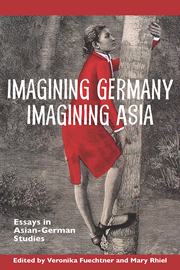Book contents
- Frontmatter
- Contents
- Acknowledgments
- Introduction
- Part I Contemporary Challenges to German Borders and Identities
- 1 East-West Globality and the European Mode of Film Production
- 2 Citizenship-Shifting: Race and Xing-Hu Kuo's Claim on East German Memory
- 3 Narratives of Transnational Divide: The Vietnamese in Contemporary German Literature and Film
- 4 Factories on the Magic Carpet: Heimat, Globalization, and the “Yellow Peril” in Die Chinesen kommen and Losers and Winners
- Part II Travel and Representation
- Part III Asia Inhabits Germany's Cultural and Intellectual History
- Bibliography
- Notes on the Contributors
- Index
1 - East-West Globality and the European Mode of Film Production
from Part I - Contemporary Challenges to German Borders and Identities
- Frontmatter
- Contents
- Acknowledgments
- Introduction
- Part I Contemporary Challenges to German Borders and Identities
- 1 East-West Globality and the European Mode of Film Production
- 2 Citizenship-Shifting: Race and Xing-Hu Kuo's Claim on East German Memory
- 3 Narratives of Transnational Divide: The Vietnamese in Contemporary German Literature and Film
- 4 Factories on the Magic Carpet: Heimat, Globalization, and the “Yellow Peril” in Die Chinesen kommen and Losers and Winners
- Part II Travel and Representation
- Part III Asia Inhabits Germany's Cultural and Intellectual History
- Bibliography
- Notes on the Contributors
- Index
Summary
The literature on globalization makes an important distinction between globalization and globality, in which the former designates contemporary processes associated with post-Cold War free market capitalism and the latter acknowledges the fact that there has always been contact in various forms around the globe. Of course, the story of Marco Polo bears individual witness to the contact between East and West, but for broader systematic examples of this contact we can turn to Janet Abu-Lughod's classic study Before European Hegemony, which details a rich and lively trade crisscrossing the planet well before the Europeans set out on the voyages of discovery. Abu-Lughod described a world system in the thirteenth century that “involved a vast region stretching between northwest Europe and China.” Historically Germany, the German-speaking territories, Europe, the Occident have always been in contact with the vast portion of the globe designated as the orient, Asia, the Mongol Empire, India, China.
The world system has taken on various forms since that time, and recent post-colonial globalization has in many ways intensified the inter-connections of East and West. Yet globality as a material condition does not necessarily translate into ideational awareness. This contact has been subjected to various parameters; the continuum of contact has been disrupted by national and racial particularization, with the result that the West and the East have seldom been imagined as being a coherent community.
- Type
- Chapter
- Information
- Imagining Germany Imagining AsiaEssays in Asian-German Studies, pp. 17 - 33Publisher: Boydell & BrewerPrint publication year: 2013



